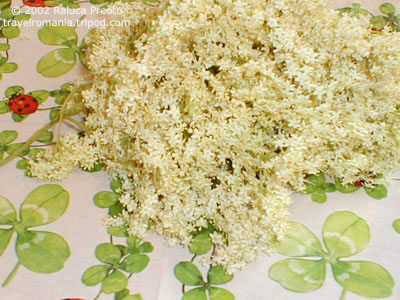 |
 |
 |
 |
 |
 |
 |
 |
 |
 |
 |
 |
Socată (Elderflower Cordial)
|
 |
 |
 |
 |
 |
 |
 |
 |
 |
 |
 |
 |
 |
 |
 |
 |
 |
 |
 |
 |
 |
 |
 |
 |
 |
 |
 |
 |
 |
 |
 |
 |
 |
 |
 |
 |
 |
 |
 |
 |
 |
 |
 |
 |
 |
 |
 |
 |
Before 1989, it used to be that at the beginning of summer both country and city folk used to make elderflower cordial
(socată).
I have taken the time to make socată this year, and inquired after recipes.
You can follow the process and results in the slide show.
|
 |
1. With caramelized sugar and vinegar
Ingredients:
5 liters water
3 large umbels
500g sugar
2 lemons, sliced
75g vinegar
|
 |
Caramelize 100 grams of sugar in a cooking pot; when melted, add 1 liter of water and the remaining sugar.
Bring to a boil and stir to dissolve the sugar, and then leave the pot to cool.
Pour the sugary water in a 5-liter jar. Add the vinegar (I have used apple vinegar), elderflowers and lemon slices (with rinds).
Fill the jar to the top with water. Cover it with gauze and store it for four days, stirring gently every once in a while.
Strain and store in the refrigerator in well-sealed bottles. I used a strainer lined with gauze.
You can try a denser fabric, such as muslin.
|
 |
 |
 |
 |
 |
 |
 |
This is the original recipe. I have gotten a different result by changing the quantities and proportions.
I have used 300 grams of sugar to the 5 liters of water and doubled the quantities for the remaining ingredients.
I served this socata diluted with mineral water.
Changing the proportions to such extent also changes the taste. The result departs from traditional Romanian elderflower
cordial in that is more refreshing but also has a more pronounced taste of vinegar.
|
 |
 |
 |
 |
 |
 |
 |
2. Plain socata
Ingredients:
5 liters water
2 large umbels
500g sugar
juice of four lemons and rind of two lemons
(a version of this recipe also adds 5 grams of yeast)
|
 |
Dissolve the sugar in 2 liters of boiling water and leave to cool.
Pour 3 liters of water in a jar. Cut the lemons in half and squeeze the juice into the jar.
Add the rinds of three lemon halves and the elderflower heads. Pour the remaining water, and cover the jar with gauze.
Stir 2-3 times daily for 3-5 days. (Again, remember to stir.)
Strain and store in the refrigerator in bottles with paper corks. I have asked and these are supposed to be conical paper corks.
|
 |
 |
 |
 |
 |
 |
 |
I am assuming the paper corks are meant to let carbon dioxide out. One recipe from 1975 advises readers to tie the corks down when they refrigerate the socata, as the drink will continue to build carbon dioxide
during refrigeration.
This third recipe also gives lemon salt as a possible substitute for lemons.
Note that the time and proportions of ingredients vary greatly from one recipe to another.
A third recipe (the one from 1975 mentioned above) advises to leave the socata to ferment only 48 hours.
Ingredients also come in very different proportions.
Here they are, for 5 liters: 500g sugar, 4-5 umbels, 2 lemons, 150 caramelized sugar (dissolved in water), 5g yeast.
Enjoy the slide show, and good luck making socata!
|
 |
 |
 |
 |
 |
 |
 |
Thank you for stopping by! It's good to have you here.
If you'd like to stay posted of new pictures, recipes, and other TravelRomania news, send me an email
with "subscribe" in the subject line. |
 |
 |
|
 |
 |
 |

To learn more about things Romanian, try the excellent
Berlitz Romanian Phrase Book & Dictionary.
Concise yet comprehensive, the
Berlitz Romanian Phrase Book & Dictionary introduces you to meal times, types of eating places,
ordering, and goes on to translate and describe traditional breakfast dishes, cold and hot starters, soups and stews,
fish and meat dishes, meat specialties, game and poultry dishes, potato and polenta specialties, rice and pasta, common sauces,
vegetables and salads, herbs and spices, cheese types, fruits and nuts, and, finally, desserts, drinks, and even snacks. I was surprised to find
this book also mentions the drink called socata, be it with a slight error. I have spotted only two errors in this book
(socada instead of socata, and smeura instead of zmeura), so rest assured: the book is
well researched and reliable!
|
 |
 |









